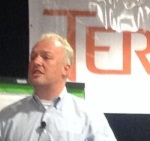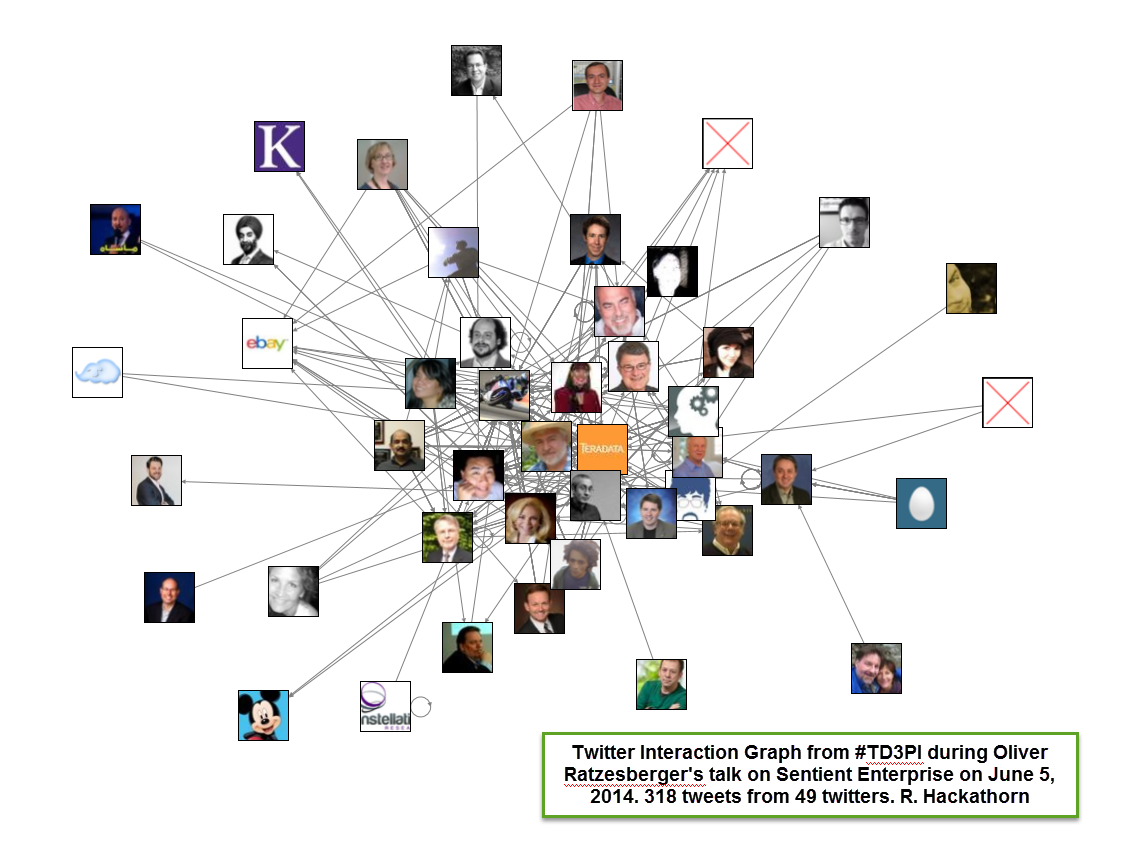Have you been in a professional presentation, and everyone around you is busy tweeting their brains out? Why? Are they vying for tweet glory or a place in Twitter heaven? Are they really listening to the speaker? And more importantly, do the tweets accurately reflect the reality of the situation?
 At a Teradata analyst briefing on June 4-5, 2014, I listened (and tweeted) to a presentation by Oliver Ratzesberger on his vision for the Sentient Enterprise in collaboration with Mohan Sawhney of Kellogg School of Management. It was an excellent, high-energy talk, in which Oliver shared his thoughts, along with emotions, about where data warehousing (plus analytics, big data, decision support, business intelligence, and all that jazz) was (and should be) heading over the coming decade. It was a strategic painting of a potential future for Teradata…so everyone was on the edge of their seats.
At a Teradata analyst briefing on June 4-5, 2014, I listened (and tweeted) to a presentation by Oliver Ratzesberger on his vision for the Sentient Enterprise in collaboration with Mohan Sawhney of Kellogg School of Management. It was an excellent, high-energy talk, in which Oliver shared his thoughts, along with emotions, about where data warehousing (plus analytics, big data, decision support, business intelligence, and all that jazz) was (and should be) heading over the coming decade. It was a strategic painting of a potential future for Teradata…so everyone was on the edge of their seats.
Let The Twitter Games Begin
Needless to say, the twitter stream for hashtag #td3pi exploded. I captured the stream using NodeXL throughout those two days, so I selected the tweets that occurred during his talk. The tweets were ordered and numbered, along with highlighting key comments. PDF transcript is here.
 There were 318 tweets from 49 twitters. However, 140 (44%) were simple retweets without comment (except for 7). That leaves 178 tweets with original context (which were highlighted in this PDF). The tweets were fairly evenly distributed over time, as shown in the profile at the left.
There were 318 tweets from 49 twitters. However, 140 (44%) were simple retweets without comment (except for 7). That leaves 178 tweets with original context (which were highlighted in this PDF). The tweets were fairly evenly distributed over time, as shown in the profile at the left.
 Most prolific analyst was @drnatalie with 29, followed by @merv 26, @prussom 23, @tonybaer 22, @hackathorn 21 and @datagenius 21. Using NodeXL, the twitter interaction graph (at the right) shows directed link indicating retweets and mentions. Simple tweets have no association and are shown the little circles. The twitter data as XLS is here.
Most prolific analyst was @drnatalie with 29, followed by @merv 26, @prussom 23, @tonybaer 22, @hackathorn 21 and @datagenius 21. Using NodeXL, the twitter interaction graph (at the right) shows directed link indicating retweets and mentions. Simple tweets have no association and are shown the little circles. The twitter data as XLS is here.
I then paraphrased this tweet stream, trying not to add new information, but letting the tweets speak for themselves. This paraphrase as PDF is here.
Scan the paraphrase. If you were there, does this capture a valid overview of the talk? If you were NOT there, does this capture an understandable overview of the talk?
My Take
I was surprised. I feel that we (especially me!) should be more discerning in our twittering of professional events. Here is my reasoning:
- Tweet streams typically attempt to report on the content, rather than sharing reactions to the content. @neilraden stated this insightful point, ” A lot of reporting in these tweets. But not much discussion. Where’s the dialectic all you analysts?” (#219).
- Tweet streams do not completely capture the content of a talk. For that, video and post to YouTube. Even if there were thousands of twitters in the room, the stream would still be fragmented and bias toward short pithy comments by the speaker.
- A simple universal convention is needed to distinguish between (a) reporting what the speaker is saying versus (b) stating your opinion about what the speaker is saying. I begin text with quotes for (a) but we need a way of indicating (b). What about beginning with an exclamation mark?
- The speaker could learn a great deal about what the audience is perceiving. There is information in those tweets, which brings us to some suggestions…
Suggestions
- As industry analysts, we should leave the reporting to reporters, video recorders, and the slide decks. Concentrate upon… How do you feel about what the speaker said? Do you agree or not? What are the not-so obvious implications? Is the speaker clear or confusing? As @neilraden asked, “Where’s the dialectic?”
- However, capture those creative (almost subjective) concise summaries by the speaker. As a speaker, I often realize that I had a great way of stating a point in front of the audience, but afterwards I could not remember that exact phrasing!
- Listen first! Then tweet in a burst.
- Tweet concisely. Don’t labor over the text. If you exceed 140 characters, your thoughts are not concise. Forget the tweet, and listen instead .
- Speakers should review the tweet transcript to identify where you were in the zone with your audience. Where did you have generated controversy or confusion? Ask yourself honestly whether you conveyed your intended message. And then reply (professionally and with thought) to the victims of your rant. Now starts the conversation.
- Event sponsors should also review the tweet transcript for valuable information about the audience. Who is listening? Who is contributing? Who has insights that will accelerate or negate the talk’s points? At the event wrap-up, award a prize for tweets that shared critical insights to the group.
- Twitter as a technology is still immature. Lacking is the ability to precisely capture and accurately analyze context. There was lots of noise in those tweets, requiring considerable manual editing! Where are the analytic tools when you need them?
Comments? What is your experience with twittering at professional presentations? What would you suggest to increase the effectiveness of twittering?
